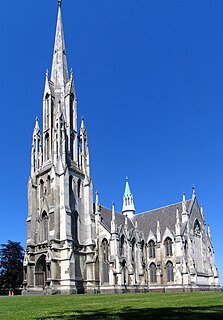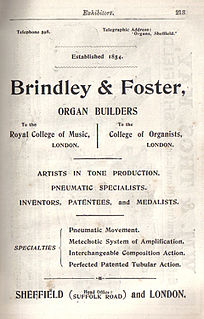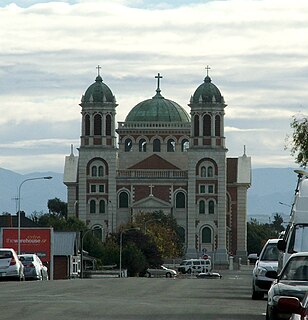
The South Island Organ Company is a manufacturer of pipe organs in Timaru, New Zealand. The company, in business since 1968, has manufactured and restored over 300 pipe organs throughout New Zealand, Australia and Oceania.

The South Island Organ Company is a manufacturer of pipe organs in Timaru, New Zealand. The company, in business since 1968, has manufactured and restored over 300 pipe organs throughout New Zealand, Australia and Oceania.
South Island Organ Company was established by Garth Cattle (from Osmond of Taunton) and Vic Hackworthy (from Hill Norman & Beard of London).
During the 1970s employed John Gray, of Hill Norman & Beard, London as voicer, John Hargraves, of John Lee, Feilding as an organ builder and Neil Stocker as an apprentice.
The new Company made an immediate impact with the rebuilding of St Johns, Invercargill (1931 3/37 HN&B/Lewis), the restoration of All Saints (1877 2/18 Bevington) and the rebuilding of St Matthew's (1879 3/26 Bevington) Dunedin and Christchurch Cathedral Nelson organs in the first two years. These soon led to our first new organ at Craighead School (2/15), Timaru in 1970 and in 1973 the first 4 manual organ built in New Zealand for many years at St Paul's Cathedral, Dunedin (4/61 Willis). In the same year organbuilder Gerald Green (of Hill Norman & Beard, Lewes) joined the company.
By 1973 South Island Organ Company purchased both existing South Island sole-trader organ builders and built a new factory at Washdyke. In 1974, South Island Organ Company extended to the North Island of New Zealand. The first North Island installation being a new organ for Our Lady of Lourdes in Palmerston North (2/3 rank extension).
In the mid 1970s, in addition to building new pipe organs and rebuilding old instruments, South Island Organ Company began promoting conservation and preservation of New Zealand historic organs. This developed from a growing realization of the fragility of the resource in a largely unregulated market, and a conviction that the future of the organ was as a work of original artistry and craftsmanship.
By 1980 South Island Organ Company had built, rebuilt, and restored seven Cathedral organs in New Zealand, including a second new tracker organ at Old St Paul's Cathedral (2/20) Wellington in 1977 and the first notable historic restoration, the 3 manual 1878 Halmshaw & Sons organ at Cathedral of the Blessed Sacrament Christchurch (3/27) in 1978.
Historic restoration brought with it a new appreciation of tubular pneumatic action organs culminating in the restoration in 1985 of the 1906 Norman & Beard 4 manual concert organ in Wellington Town Hall . The success of this project led to further pneumatic action restorations and overseas interest and in 1990 the company's first project in Australia, transplanting and rebuilding the 1868/1891/1953 (3/32) George Fincham organ from St Kilda Blind Institute for Paton Memorial Uniting at Deepdene. This was soon followed by the restoration of the George Fincham organs at Church of All Nations (1876, 2/13), Carlton and Trinity Uniting (1884, 2/14), Brighton in 1992, and in 1993 Victoria's prime historic organ at St Mary Star of the Sea (1899, 3/38) West Melbourne.
South Island Organ Company operates out of its third factory built in 1985 at Washdyke Industrial Park. The Company regularly tunes and maintains over 300 pipe organs over Australasia.
On 22 February 2011, an earthquake struck Christchurch, New Zealand taking the lives of South Island Organ Company's foreman Neil Stocker and factory hand Scott Lucy. Paul Dunlop, a helper from Christchurch was also killed. The deceased were a part of a team of eight which was removing the organ of Christchurch's Durham Street Methodist Church which had been badly damaged by an earthquake the previous September, and was reduced to rubble by the February earthquake. [1]

Francis William Petre, sometimes known as Frank Petre, was a New Zealand-born architect based in Dunedin. He was an able exponent of the Gothic revival style, one of its best practitioners in New Zealand. He followed the Catholic Church's initiative to build places of worship in Anglo-Saxon countries inspired by Romance forms of architecture. His basilica Cathedral of the Blessed Sacrament, in Christchurch was demolished in 2021.

First Church is a prominent church in the New Zealand city of Dunedin. It is located in the heart of the city on Moray Place, 100 metres to the south of the city centre. The church is the city's primary Presbyterian church. The building is regarded as the most impressive of New Zealand's nineteenth-century churches, and is listed by Heritage New Zealand as a Category I structure.

St Joseph's Cathedral in Dunedin, New Zealand, is the Roman Catholic Cathedral for the Roman Catholic Diocese of Dunedin. It is located in City Rise, some 0.5 kilometres (0.31 mi) to the west of the city centre.

The Latin Rite Roman Catholic Diocese of Christchurch is a suffragan diocese of the Roman Catholic Archdiocese of Wellington. Its cathedral and see city are located in Christchurch, the largest city in the South Island of New Zealand. It was formed on 5 May 1887 from a portion of the territory of the Diocese of Wellington, which was elevated to archdiocese later that same month.
The architecture of New Zealand, though influenced by various cultures, expresses predominantly European styles. Polynesian influences emerge in some areas.

St Paul's Cathedral is the mother church of the Anglican Diocese of Dunedin in New Zealand and the seat of the Bishop of Dunedin.
This article is about the numerous notable pipe organs of the city of Brighton and Hove, from the small early 19th-century organs to the large 20th-century instruments in the large churches.

Brindley & Foster was a pipe organ builder based in Sheffield who flourished between 1854 and 1939.
Arnott Maxwell Fernie was a New Zealand organist, teacher and conductor. He was an authority on Gregorian chant, sixteenth century polyphony, organ construction and tonal design.
George Fincham was an organ builder active in Australia.

All Saints has been open since 1865, and is presently in the Dunedin North parish which includes the northern part of the city of Dunedin, New Zealand and is made up of the former parish of All Saints and the former parish of St. Martin's North East Valley. It is part of the Diocese of Dunedin. The parish boundaries include North East Valley, Pine Hill, North Dunedin, Ravensbourne and Leith Valley. The building is the oldest church still used as a place of worship in Dunedin. All Saints Church is the chapel of Selwyn College, Otago. The College was built around the church and the college and parish have a close relationship. Selwyn College was built as an Anglican theological college in 1893, from the beginning it also housed non-theological students from the university. All Saints' is located close to the campuses of the University of Otago and the Otago Polytechnic.

The Church of St Michael and All Angels is an Anglican church in Christchurch, New Zealand. The church building at 84 Oxford Terrace, Christchurch, is registered as Category I by Heritage New Zealand. Its freestanding belfry is registered separately.

St Saviour’s at Holy Trinity is an Anglican church in Lyttelton, Christchurch, New Zealand. St Saviour's Chapel was relocated from West Lyttelton to Christchurch's Cathedral Grammar School in the 1970s. Following the earthquakes and the demolition of Holy Trinity Church, Lyttelton, St Saviour's was returned to Lyttelton to the site of Holy Trinity in 2013.
Norman and Beard were a pipe organ manufacturer based in Norwich from 1887 to 1916.

The Waiapu Cathedral of Saint John the Evangelist, Napier, is the formal name of the Anglican Cathedral of the Diocese of Waiapu. It is more commonly called either Waiapu Cathedral or Napier Cathedral. The Waiapu cathedral is situated at the north end of the central business district of Napier, New Zealand. Construction of the present building was completed 1965, and the cathedral was consecrated on 8th October 1967. It is built in an Art Deco style.

The Sacred Heart Basilica or Timaru Basilica, as it is popularly known because of its style of architecture, is a Catholic church in Timaru, New Zealand. It was designed by the prominent New Zealand architect, Francis Petre and is one of his most celebrated works. Its great size and beauty make it one of the most important historic buildings of Timaru and of the South Canterbury region. The Basilica's twin towers and copper cupola are highly visible features of the Timaru skyline, especially from the south. The Basilica is also one of the "most noteworthy examples of ecclesiastical architecture" in New Zealand with elements of "Roman and Byzantine architecture with touches of Art Nouveau decoration." It is a registered historic place, category 1.
Henry Bevington was a prolific English organ builder, active in London during the Victorian era. Many of his organs were erected in Australia and South Africa.(van der Linde 1993)
A. Hunter & Son was an English pipe organ maker and refurbisher, established in London in 1856. Hunter was best known for the instruments at St Cuthbert's Philbeach Gardens and St James's, Spanish Place. The firm was acquired by Henry Willis & Sons in 1937.